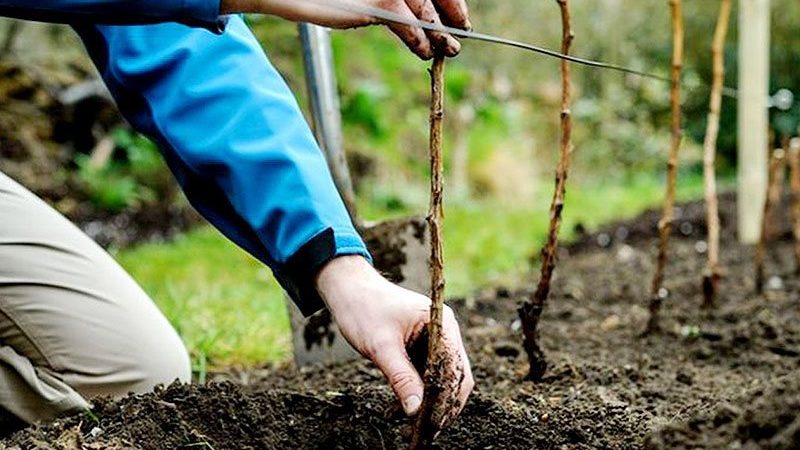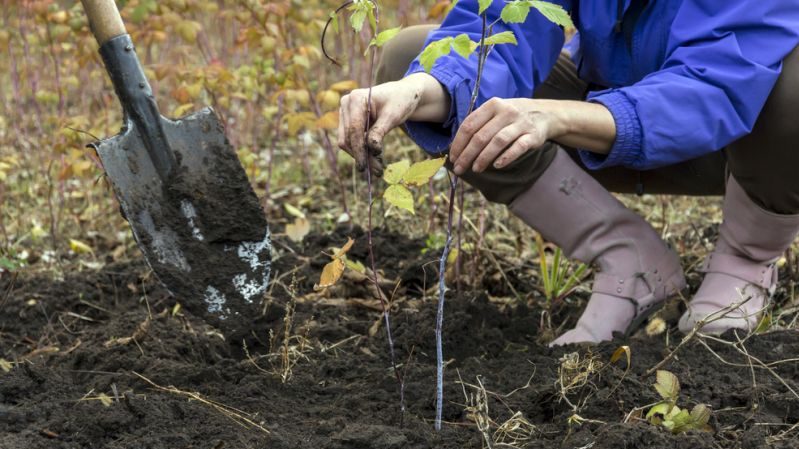How to properly plant raspberries in the fall and take care of them further
It is impossible to unequivocally answer the question of when is it better to plant raspberries. But there is a general observation that bushes planted in autumn take root better than spring ones and give a higher yield.
How unmistakable choose raspberry variety for autumn planting, how to properly plant and care for a plant - we will tell you further.
The content of the article
The best raspberry varieties for autumn planting
For planting raspberries in autumn, frost-resistant varieties are suitable, which include:
- Atlant. High-yielding variety. The berries are sweet, large, weighing up to 8 g. Gives 2-3 harvests per year. The first harvest can be harvested in mid-June, and the last harvest in early September. The variety is resistant to frost, diseases and pests. Requires abundant watering. Suitable for growing throughout Russia.
- Zyugan. Refers to perennial shrubs. The berries are large. A high-yielding variety - you can harvest up to 6 kg of raspberries. A distinctive feature in the absence of thorns, which makes picking berries easier. Needs a garter and support. Bears fruit in the second year. Frost resistant.
- Polana. A variety with large berries weighing up to 14 g. It is popularly called a raspberry tree. It has no thorns and needs support. Fruiting in July and August. It perfectly tolerates frosts down to -30 ° С. The variety is resistant to pests and diseases.
- Monomakh's hat. Raspberry variety with bright red berries up to 12 g. Productivity - 4 kg per bush. Fruiting from August until the first frost. It is good to grow in Central Russia. It tolerates frosts down to -25 ° С.
Selection and preparation of seedlings
To obtain a rich harvest of berries, high-quality planting material is needed.
When buying a seedling, pay attention to the following signs:
- well-developed root system (length - up to 10 cm);
- flexible, smooth shoots, thickness at the base - about 1 cm, height - up to 30-40 cm;
- shoots must have formed buds;
- free from signs of diseases and pests;
- the seedlings should not be damaged.
Before planting, the root system of the bush must be wrapped in moist material and polyethylene on top so that the roots do not dry out.
It is best to buy raspberry seedlings with closed roots (in containers), since they have a higher survival rate.
Attention! When buying, choose a variety that is zoned for a specific region and its climate. It is more correct to buy planting material in nurseries and garden centers.
Landing dates

The timing of the autumn planting of raspberries depends on the climatic conditions of the region and varietal qualities.
So, in the south of Russia, raspberries are planted in late autumn, in the second half of October. In the suburbs and the middle lane - at the end of September. In colder regions (in the North-West of Russia, Siberia and the Urals), the berry is planted earlier - in the first decade of September.
Raspberries must be planted in such a way that 20-30 days remain before the first frost. During this period, the seedlings must take root and adapt to new conditions. Therefore, you need to focus on the current weather conditions and the mid-term forecast.
How to plant raspberries in the fall
When planting raspberries, you must follow a number of recommendations in order to get an excellent harvest in the future.
Seat selection
Raspberries need the most sunlit place.She does not like wind and drafts, so the ideal site is on the south side by the fence. The culture is moisture-loving, but waterlogging negatively affects its root system, rot appears.
Attention! You can not plant raspberry seedlings in lowlands and in areas where water stagnates.
Raspberry grows well on fertile, sandy loam, loamy, neutral soils.
The best precursors for raspberries are pumpkin, cucumbers, squash, zucchini and green manure. The bad ones are eggplants, tomatoes, potatoes and strawberries.
It is undesirable to plant raspberries next to trees, grapes and sea buckthorn. The best neighbors are dill and blackberries. It is re-planted in the same place only after 5-6 years.
Required materials and tools
You need slate, a board, old containers with a diameter of 50-60 cm, a shovel, gloves, a bucket or watering can, insulation, wood ash, organic and mineral fertilizers.
Step-by-step instruction
With the bush planting method, holes are dug with a diameter of 50-60 cm and a depth of 40 cm.
A bucket of humus, 30 g of superphosphate and 30 g of potassium salt are poured onto the bottom, everything is mixed and poured with 8 liters of water.
The seedling is placed in the hole, the roots are spread and covered with earth. To eliminate air pockets, the seedling is lightly shaken during planting. At the end of the process, the soil around it is compacted.
Then the sapling is cut off - the pruning shears are shortened so that a segment of 15-20 cm with 3-5 buds remains.
Water the seedling again with water (8-10 l), the soil around it is mulched with peat, humus or sawdust.
Mistakes to Avoid
Even experienced gardeners sometimes make mistakes:
- The raspberries are planted early. She managed to release young shoots before the frost, so she will not be able to overwinter.
- The plant is planted late or cut off too high, because of which it did not have time to take root. May die during the winter.
- The raspberry tree is organized in a highly shaded area. The plant is strongly drawn to the light, spends energy on it, the berry yield decreases.
- Low-quality planting material is used - plants that are too mature, with dry roots, damage and diseases.
- The distance between plants was not maintained, the plantings were thickened, which negatively affects the yield.
Planting methods
Raspberries in summer cottages and household plots are most often planted by bush (pit) and trench methods, and in farms the belt method is most often used.
The bush method is the most common; it is best used in regions with high humidity. In a thin raspberry tree, there is good ventilation between the plants, therefore, the incidence of diseases is reduced. No preliminary preparation of the site is required, all fertilizers are applied during planting.
Belt method involves the formation of strips (rows) of seedlings. With such a dense planting, the rows are filled with shoots, and fruiting is accelerated. The yield is higher, but it is also more difficult to care for them.
Container way used in small areas. A raspberry seedling is planted in a container, which is buried in the ground.
With the trench method dig a trench 50 cm deep and 60 cm wide, lay a nutrient layer from the branches on the bottom, foliage, humus.
Attention! Plank or slate can be laid out along the edges of the trench to prevent raspberry bushes from spreading to other areas.
At what distance and at what depth to plant
Such a distance is left between the seedlings so that there is enough sun, air, space for growth and care for them. The distance and depth of planting depends on its method.
If the seedlings are planted in rows, 1-1.2 m is left between them, and 1-1.5 m between the rows.The depth is 30-40 cm.
With the tape or trench method, the distance in the rows is 50-60 cm, between the tapes - 1.8-2 m, the depth is 50-60 cm.
Further care of seedlings
Care after planting is to maintain soil moisture and prepare for winter.
Usually there is enough rain in the fall, so additional watering is not required.In dry autumn weather, the seedlings are watered after 2-3 days with warm water and spud so that there is no crust on the ground.
For fast rooting of plants, you can use "Kornevin" or "Heteroauxin". The first time it is watered with a solution (2 l) after planting after 10-12 days, watering is repeated after the same period.
Many people also use folk remedies - infusions of nettle, onion husks and male fern... The recipe is the same: 1 kg of the product is infused in 10 liters of water for two days. When watering one seedling, use 1-2 liters of infusion.
A thick layer (up to 10-15 cm) of mulch is poured in advance before frost to protect the root system. Immediately before frost, the plantings are covered with insulation.
Reference. Peat, sawdust, straw, decayed foliage or compost are used for mulching.
Features of autumn planting, depending on the region

Breeders have developed frost-resistant raspberries for cultivation in cold climates.
In the cold regions of Siberia and the Urals raspberries are planted in early September or planting is postponed to spring. This is due to the fact that autumn is rainy and cold here. Saplings often do not have time to take root and die. It is better to use frost-resistant varieties of raspberries, and use the trench method for planting - it helps the plants survive the harsh winter. The raspberry tree must be placed in the depths of the garden - this way the seedlings will be protected from the wind.
In southern areas, the best time to plant - the period from mid-September to early October. Young saplings will have time to take root well before the first frost, overwinter and begin to grow actively in spring.
In the middle lane, Moscow region favorable time for planting - September. Frost-resistant raspberry varieties take root here.
Conclusion
If you correctly choose seedlings for autumn planting, implement it correctly and take care of raspberries, the result will not be long in coming. A well-groomed raspberry tree will give strong shoots and a rich harvest. If the planting dates are met, the seedlings quickly take root and bear fruit every year.